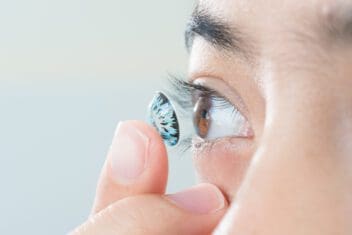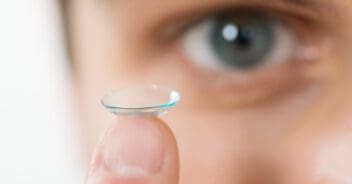Last Updated
Further Reading
- Wearing Daily Contacts More Than Once
- How to Remove a Stuck Contact
- Non-Prescription Colored Contacts
- Post-LASIK
- RGP (Hard) Contacts
- Do They Expire?
- Bifocals
- Multifocal Lenses
- Toric Lenses
- Buying Contacts Online
- Risks of Colored Contacts
- Colored Lenses for Astigmatism
- Contacts & Cloudy Vision
- Deciding Between Contacts & Glasses
- The Best Contact Lenses in 2020
- How Long Do Contacts Last?
- Costs in 2020
- How to Overcome Contact Problems
- Blurry Vision From Contacts
- Contacts for Astigmatism
- Keratoconus Lenses
- Monthly Contacts Longer Use Safety
- Dangers of Sleeping with Them In
- Colored Lenses
- Are Halloween Costume Contact Lenses Safe? What You Need to Know
Are Sclera Contacts Dangerous
Home / Understanding Contacts /
Last Updated
Sclera contacts are not dangerous, but there are some risk factors associated with their use.
Table of Contents
Sclera contacts are a specialty lens that are custom made and fitted to each individual. They are designed to vault over the cornea and rest on the sclera, leaving room for fluid between the lens and the cornea. These are rigid and gas permeable contacts.
These contacts are best for people who have irregularly shaped corneas, do not tolerate soft contact lenses, or have severe dry eyes.
Most of the issues associated with sclera contacts are due to improper fitting or handling of these specialty lenses.
Possible Complications of Sclera Contacts

There are many myths surrounding sclera contacts, including the fact that they can be dangerous to wear. According to Optometry Times, however, there is little scientific evidence or research to support that scleral contact lenses have negative long-term complications.
In fact, these contact lenses have been successfully used for decades. They have even been shown to reduce the need for transplant surgery in people who suffer from significant keratoconus.
One of the biggest drawbacks to sclera contacts can be their cost. These lenses are custom fitted, which means that it takes a trained professional more time and effort to get them right. Each lens is individually crafted, which can drive up the cost. In the long run, however, scleral lenses are generally not drastically more expensive than other specialty contact lenses.
The National Keratoconus Foundation (NKCF) publishes that complications from wearing scleral contact lenses are relatively rare. Possible hazards of sclera contacts can include:
- Corneal swelling or edema.
- Blood vessels growing into the cornea.
- Corneal infections.
- Lens fogging.
- Eye pain or discomfort.
- Conjunctival prolapse.
- Bubbles getting trapped between the lens and cornea in the lens fluid reservoir.
Most of the potential dangers of scleral contact lens use are related to user error or a poor lens fit.
When to Use Sclera Contacts
Scleral contact lenses can be a great option for people who have had trouble wearing traditional contacts. They are bigger lenses, and this can be helpful in improving vision for a variety of eye conditions and issues.
Sclera contacts are different from soft contact lenses in that they are made from a rigid gas permeable (RGP) material. These contacts don’t touch the front of the cornea like most contacts. Instead, they rest on the sclera on the outer layer of the eyeball.
Scleral lenses can be good for people who:
- Have irregularly shaped corneas or suffer from keratoconus, a condition that causes the cornea to form a dome shape. This shape makes traditional contact lenses difficult to fit.
- Suffer from eye disease or have a history of eye infections. Since the scleral contact lenses do not make contact with the corneas, they can better protect the eyes.
- Have had eye surgery, such as a corneal transplant, or trauma to the eye. Scleral contact lenses can allow the eyes and cornea to heal without direct contact with them.
- Struggle with severe dry eye. Contacts can often make dry eye worse, but scleral contact lenses leave room for fluid between the lens and the cornea. This can help keep the eyes more hydrated.
Scleral contact lenses can be custom designed and fit to handle any level of irregularity or steepness in the corneas. They can correct vision even in cases of extreme astigmatism, myopia, or hyperopia.
Since scleral contact lenses do not rest on the cornea directly, they are often more comfortable to wear. The sclera, where they do rest, is a less sensitive area of the eye. Scleral contact lenses can also help to protect the eye from irritants and promote healing of the cornea after trauma or surgery.
Wearing Sclera Contacts Safely
Scleral contact lenses need to be properly fitted in order to be safe.
Are sclera contacts dangerous? The answer is that they can be if they are not fit and customized by a trained professional.

Improper fit can lead to a host of complications, including corneal edema, swelling that occurs due to excess fluid being trapped under the lens, and hypoxia, which is when not enough oxygen passes through to the underlying tissue. The right fit can decrease the risks for serious side effects.
Most complications with scleral contact lenses relate to poor handling by the user. Sclera contacts are generally bigger than regular contact lenses and need to be placed properly in the eye each time. Incorrect application of a scleral lens can cause bubbles to be trapped.
If you wear the lenses for too long and don’t clean or handle them correctly, it can lead to eye irritation, infection, and other issues.
Debris can become trapped in the tear reservoir between the cornea and the scleral lens, which can cause midday fogging of the lens. When this happens, the lens will need to be taken out and cleaned before being put back in the eye.
Scleral contact lenses can open the doors to clear and sharp vision for people who have traditionally been unable to wear contact lenses. These contacts can be safe and effective for a variety of eye conditions and refractive errors when they are fitted and used correctly.
Talk to your eye care professional about the benefits of sclera contacts in your situation.
References
- Five Myths About Scleral Contacts Debunked. (February 2015). Optometry Times.
- Scleral Lenses Reduce Need for Surgical Intervention in Severe Keratoconus. (February 2018). American Academy of Ophthalmology (AAO).
- Update on Scleral Lenses. (November 2018). American Academy of Ophthalmology (AAO).
- 5 Things You Didn’t Know About Scleral Lenses. (August 2018). Primary Care Optometry News.
- Scleral Lens Troubleshooting FAQs. GP Lens Institute, Scleral Lens Education Society.
The information provided on this page should not be used in place of information provided by a doctor or specialist. To learn more, read our Privacy Policy and Editorial Policy pages.
Further Reading
- Wearing Daily Contacts More Than Once
- How to Remove a Stuck Contact
- Non-Prescription Colored Contacts
- Post-LASIK
- RGP (Hard) Contacts
- Do They Expire?
- Bifocals
- Multifocal Lenses
- Toric Lenses
- Buying Contacts Online
- Risks of Colored Contacts
- Colored Lenses for Astigmatism
- Contacts & Cloudy Vision
- Deciding Between Contacts & Glasses
- The Best Contact Lenses in 2020
- How Long Do Contacts Last?
- Costs in 2020
- How to Overcome Contact Problems
- Blurry Vision From Contacts
- Contacts for Astigmatism
- Keratoconus Lenses
- Monthly Contacts Longer Use Safety
- Dangers of Sleeping with Them In
- Colored Lenses
- Are Halloween Costume Contact Lenses Safe? What You Need to Know